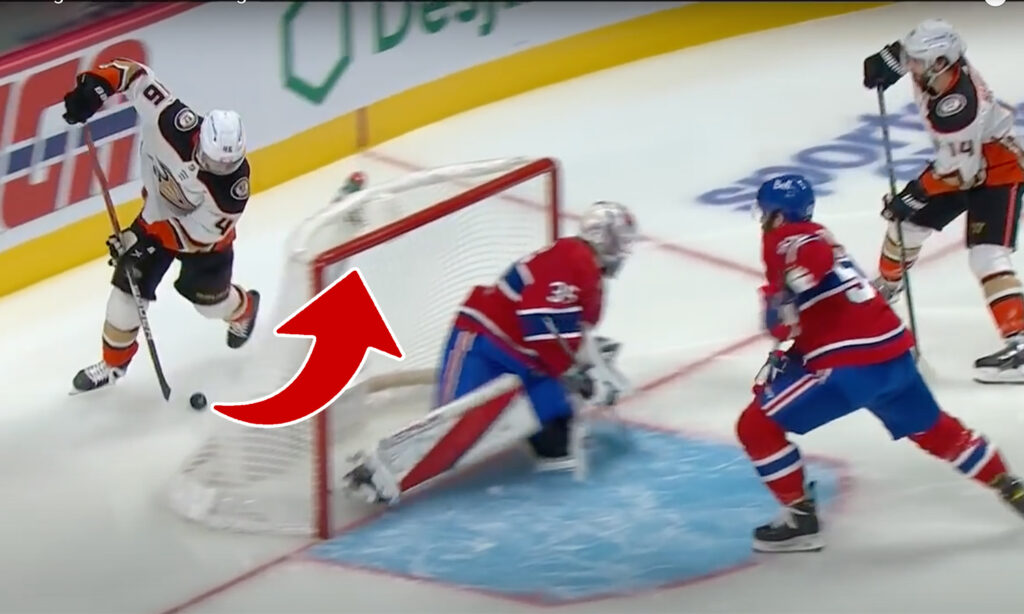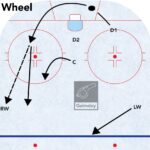Just like most sports, hockey players must learn various skills to excel at the game.
The basic skills every player must learn are skating, shooting, passing and stickhandling.
These are taught starting at a young age.
Anyone who’s played hockey since youth know the many drills your coaches put you through.
The idea was to perfect all aspects of your game and bring out the best in you.
Stickhandling is an essential part of your conditioning.
Players are taught to stickhandle in order to better control the puck while skating.
Stickhandling is also necessary to protect the puck from being stolen away from you.
When you become a master at stickhandling, your next option is to dive into the realm of deking.
What is a Deke in Hockey?
A deke is a fake or a feint movement with the puck, to go around your opponent. A successful deke will allow the puck carrier to shake off an opposing player or cause the goalie to lose position for an open net shot. In the NHL, dekes are most often carried out on the breakaway or shoot out attempt on the goalie.
That’s because players have more time to execute their preferred play when facing the goalie alone.
Deking an opponent other than the goalie can be highly risky and lead to a turnover.
It is considered a low percentage play, especially if going against more than one player.
When a team breaks out on the rush, the preferred options are to either pass the puck or dump-and-chase.
But let’s get something straight – dekes are fun to watch.
Leaving an opponent in the dust cannot feel any more satisfying. It’s the equivalent of breaking ankles in basketball.
Curious to see? Here's a video of Connor McDavid undressing four players and the goalie in mere seconds.
The hardest dekes to pull off are against a skilled defenseman skating backwards.
Defensemen not only master their balance on the back skate but are also trained to pivot side-to-side.
Add in the fact that they typically tower over the average forward, you need to be slick to make them look like fools.
Lastly, they are also trained to target your body rather than focus on the puck.
No matter how skilled you are with the puck, all they need to do is separate your body from it.
Meanwhile, the easiest dekes come when your opponent is coming right at you.
If you are skating forward with the puck, a shift in one direction usually helps shake off the opponent.
But don’t get too cocky. Dekes are harder to come by when the opposition player is much more skilled than you are.
You might get away with one deke, but a strong two-way player will chase you down.
Master of the Deke
When it comes to NHL talent, there are so many players to choose from.
But one player that had the most tricks up their sleeve was none other than Pavel Datsyuk.
You can watch highlight after highlight on YouTube and see how many moves he had in his repertoire.
Below is a small compilation video of Datsyuk’s best dekes.
While staring in amazement at his puck handling skills, you might be tempted at further developing your own during practice.
Rather than running Datsyuk on loop and breaking down his moves, you should consider watching another YouTube sensation, Pavel Barber.
While he has never played in the NHL, his entire channel is dedicated in breaking down the hardest dekes and stickhandling moves ever done.
In fact, he’s developed some of his own techniques and has even coached alongside NHL players.
Types of dekes on Goalies
When it comes to moves you can make on the goalie, the possibilities are endless.
The objective of a deke is to get the goalie to open up a side, a corner or even between the legs so that you end up scoring.
There are so many moves that they are sometimes named after the first player of significance to do so.
The ones that come to mind include the Forsberg, the Datsyuk and the Svechnikov (aka – the Michigan).
In the case of “the Svechnikov”, he wasn’t the originator of the move. The play dates back to 1996 by Mike Legg of the Michigan Wolverines.
The play involves scooping the puck off the ice and onto your blade, followed by tucking it into an open corner of the net.
In this case, the play is performed behind the net where players are usually left alone during a powerplay.
While a player behind the net is minimally dangerous, the Svechnikov changes that equation.
The play was repeated again by none other than Sidney Crosby during his days in the QMJHL.
Svechnikov was the first to do it at the Nation Hockey League (NHL) level.
It was later done again by Trevor Zegras of the Anaheim Ducks.
Other Famous Dekes
Dekes you might have heard about are the Triple Deke, Spinorama, Between-the-legs shot and so on.
Each of these have made headlines in sports news at one time or another.
The triple deke was actually made famous in the original Mighty Ducks movie.
Essentially, it was a forehand to backhand to forehand stickhandling move.
Remember, the object is to make the goalie believe you’re going one way and have them commit that side.
Once they have no chance to recover, go for the side left open.
Final Thoughts
Dekes are fun to practice and perform in a game, especially when you’re young.
Back in the day, it was frowned upon to showboat at a more professional level.
But the game has evolved and more NHLers are willing to use their skills as an advantage.
It’s one thing to deke the goalie with a brilliant move but can be risky doing so to other players.
While turning a player inside out is just as satisfying, I will share a piece of wisdom I learned at a younger age:
The puck moves faster than any player on the ice!
The point is that passing the puck moves the play at a quicker pace than any individual player can.
You can deke one player, but there are four other skaters to cut you off.
If the opposition suspects that you’re more of an individual rather than a team player, they will converge on you and strip the puck off.
You must be as much of a passing threat as you are a stickhandling menace to successfully pull these dekes off.
Don’t be a one-trick pony on the ice and watch your game flourish.






